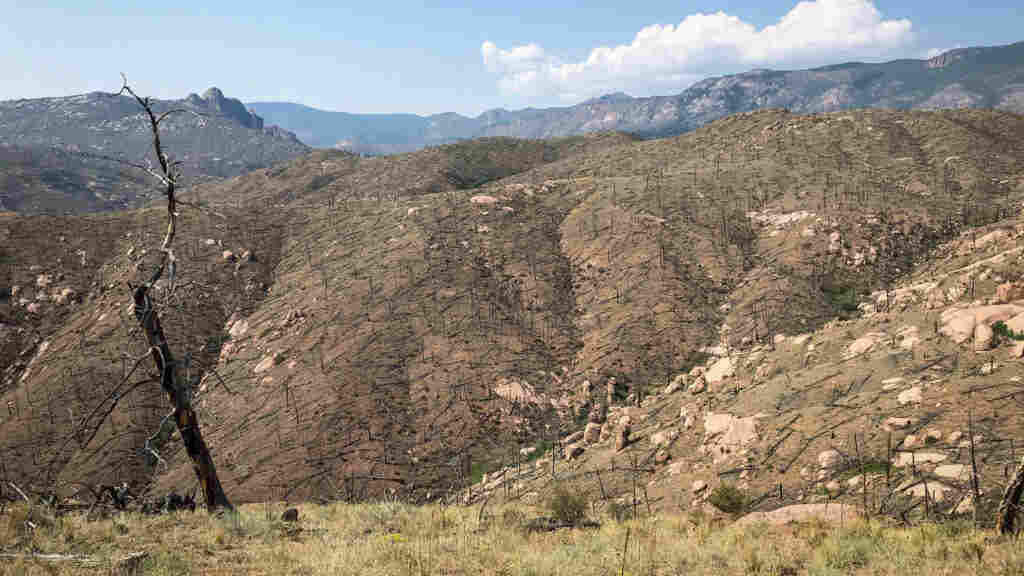
Michael Elizabeth Sakas/CPR News
Greenwire had this story on Feb. 26: “Annual wildfires hurt forests’ carbon retention — study.” The study ($), “Decadal changes in fire frequencies shift tree communities and functional traits, is here.
This is what some of us on Smokey Wire and elsewhere have been saying for years.
Excerpt:
Repeated, intense wildfires have damaged forests’ ability to grow fire resistant and store carbon, causing scientists to rethink how to deploy tree-planting efforts after natural disasters.
After 50 years, regions with the most extreme annual fires suffered from a 63% smaller wooded area with almost three-quarters of the individual trees than in regions that never burned, according to the study published in Nature Ecology & Evolution.
Even in regions with tree species that are well-equipped to withstand frequent burnings, fires over the past couple of decades have often decimated fire-resistant adult trees, while younger saplings haven’t been able to reach maturity.
“After a fire, a small tree has to regrow the biomass that it lost during the fire, which takes time,” said Adam Pellegrini, a co-author of the study and professor at the University of Cambridge. “The more frequent a fire is, the lower probability that the trees can grow fast enough to become resistant.”
It’s not just frequent fires, as you can tell from the Hayman fire photo above.
Which reminds me of another study… https://www.koaa.com/news/covering-colorado/new-study-finds-portions-of-burned-forestry-may-convert-to-grassland
If fires burn too frequently, young trees will burn up before they get old. If there are no seed trees around, there will be no natural regeneration. Not sure that we need additional studies to prove these points.
Agreed, the reduction of tree cover from catastrophic fires over extensive acreage even changes the local atmospheric environment & therefore the probability of conversion to grasslands increases dramatically.
Then the probability of any tree seeds that make it over intervening grasslands and penetrating through the thick turf to the soil goes way down so access to critical nutrients and minerals is somewhere between slim and none. The icing on the cake is that competing grasses get the limited moisture from dew and rain before the trees get what is left over. Eventually the soil composition even changes to a soil not suited for tree growth. Efforts to establish trees in the US plains have shown that extremely intensive efforts are required to plant and maintain such stands. Most of those stands are now gone & none of them was of significant size to modify conditions sufficiently to create a self sustaining environment.
No, we don’t need more studies. We just need to look at the much neglected studies that were published before the internet existed. And we sure as heck need to look with a jaundiced eye at “walk through the woods opinions passed of as science” when they ingnore the long & extensively validated principles of plant physology and other pertinent sciences.
As i said here before, i think the people and their polticians are increasingly realizing that they’ve been sold a false bill of goods.
Too bad that the uninformed emotions of “enviros” with money to throw at politicians have had their way for so long. However, the writting is now on the wall for all to see.
Hi Guys,
I really like your observations, however I am trying to understand the “politicians have been sold a bill of goods” part. What bill of goods have they been sold?
You haven’t been reading here very much. We’ve got some “there is no sense in trying to stop fires” individuals here.
Then there is the “leave the forest alone. We don’t need thinning or other fuel treatments” crowd and probably some others that don’t immediately come to mind.
They like “natural fire”, meaning that it stays low and doesn’t burn intensely, ignited by lightning. The trouble with that idea is that over 85% of all US wildfires are human-caused. We should never ignore human impacts on our forests.
I see a difference between fire frequency and intensity and they work against each other. If fires are frequent, they are less likely to be intense. Also if fires are frequent, this is more likely a result of climate than the fuel build-up that has contributed to today’s historically intense fires. It seems to me that planting would be more effective to help jump-start recovery from a one-off overly intense fire than in locations were the climate now demands frequent fires.
Once again probably to little to late. Maybe, just maybe the FS will try to put out summer fire when they start. Maybe I won’t have to keep hearing how good fires are for the forest.
We could be busy planting trees on decimated federal forests for decades. Think of jobs that could create. Or we can continue to watch our forests disappear.
The RMRS recently published a brief report on research at Lick Creek in Montana. Excerpt:
These results demonstrate that treatments aimed to reduce
potential wildfire severity can have the added benefits of
sequestering carbon, increasing resistance to mountain
pine beetle outbreaks, and improving resilience to drought
stress. There will likely also be additional benefits of
enhanced growth and physiological activity under climatic
stress, and the effects may persist for more than two
decades. But the decades of research at Lick Creek show
that to maintain these ecosystem services, fuel treatments
must be part of a recurring regime of treatments used
over time. Continued monitoring after re-treatments is
important to determine if treatment efficacy is sustained
and how non-native plant species respond.
https://www.fs.usda.gov/rmrs/sites/default/files/documents/SYCU_in5_SeeingTheBigPIcture_LickCreek.pdf
I think this scenario is at play in some areas: An overcrowded forest where fire has been excluded for decades burns at high intensity, killing most trees; seed sources except at the edges are eliminated. Brush, grass, maybe invasives move in and the next fire is also “intense,” meaning that it consumes all or most vegetation. Subsequent fires may be more or less frequent than before fire exclusion, but the vegetative cover change is persistent.